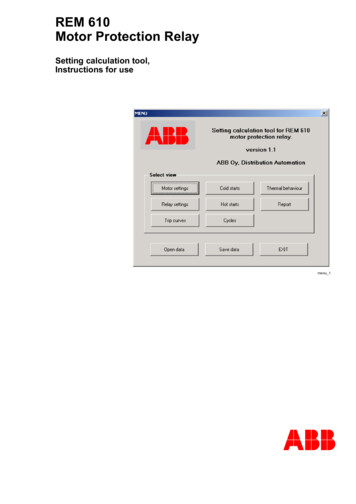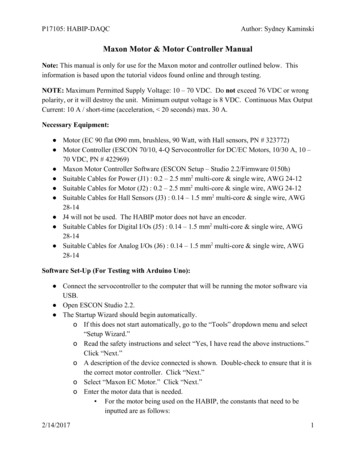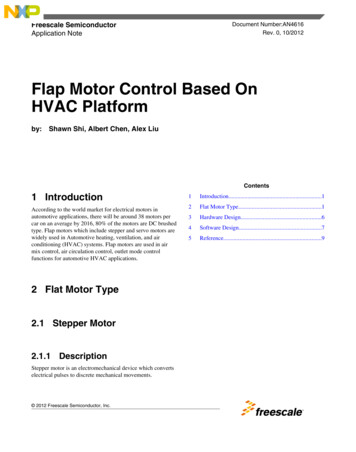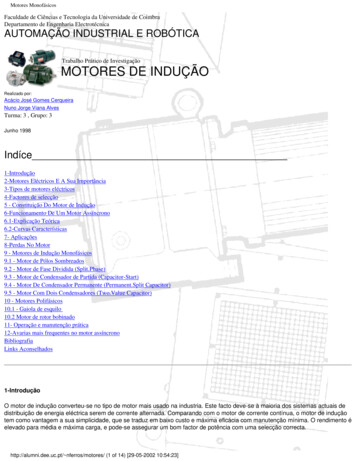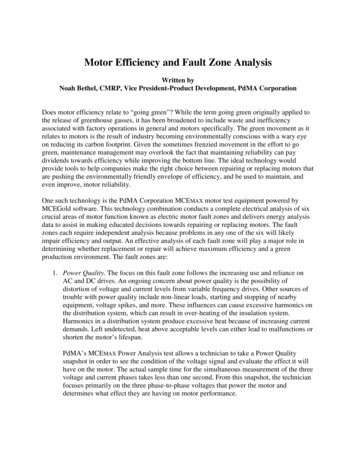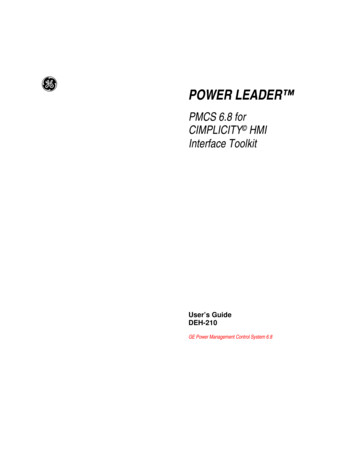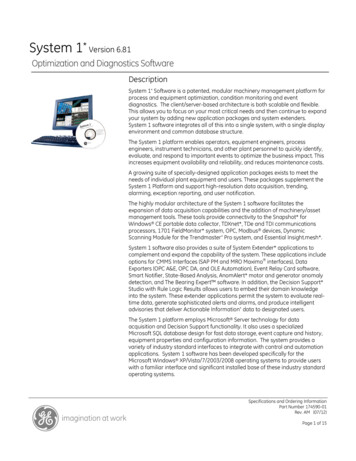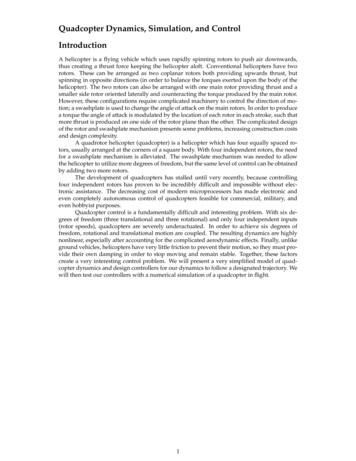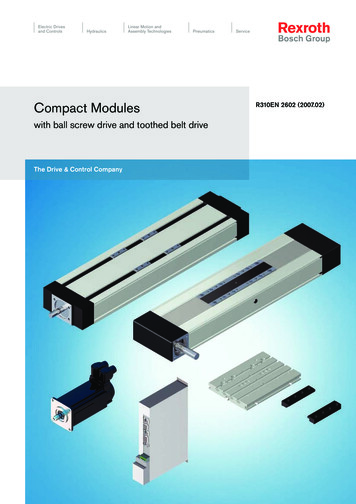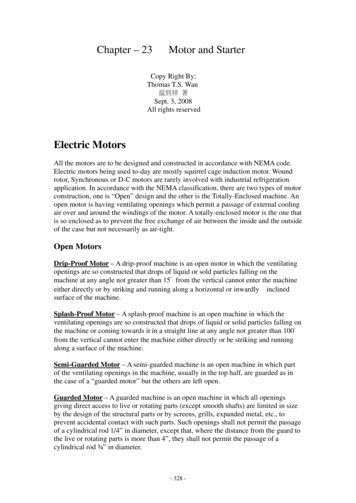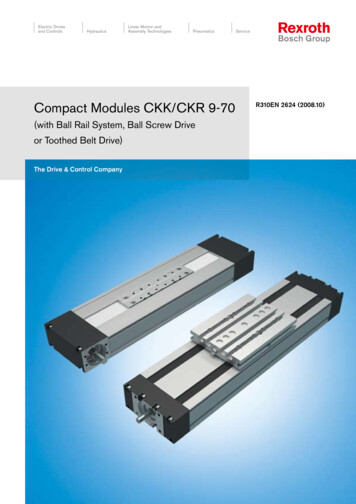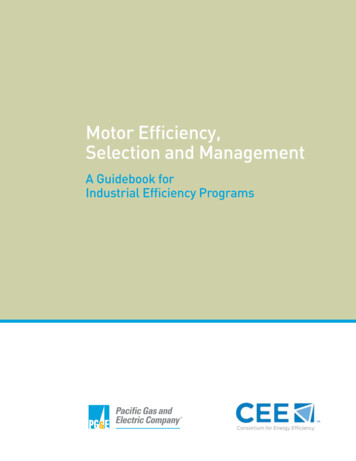
Transcription
Motor Efficiency,Selection and ManagementA Guidebook forIndustrial Efficiency Programs
For more information, contact:Keith Forsman, P.E.Customer Energy Solutions—Core ProductsPacific Gas and Electric CompanyKef1@pge.com415-973-2380245 Market StreetSan Francisco, CA 94105Robert HartIndustrial Program Manager—Motors & Motor Systems CommitteeConsortium for Energy Efficiencyrhart@cee1.org617-337-927398 North Washington Street, Suite 101Boston, MA 02114
Motor Efficiency, Selection, and ManagementA Guidebook for Industrial Efficiency ProgramsIn the fiercely competitive global marketplace, minimizing operational costs can mean the differencebetween success and failure for many companies. Recent reports estimate that motor-driven systemsare the largest electrical end use in the industrial sector1. As a result, optimizing motor system efficiencycan significantly reduce operational costs. However, in many ways, motors are critical to keep facilitiesoperating, and making changes to such a critical function requires careful evaluation of any potentialimpacts on overall system performance. Given the complexity of these systems, it is important tounderstand not only motor efficiency but also other selection considerations such as motor design,speed and the opportunity to use adjustable speed drives (ASDs).This guidebook is an informational resource that identifies motor-related considerations that affect theoverall efficiency of motor-driven systems. The readers who will find this guidebook most useful arethose who need a basic, non-engineering overview of general-purpose motors, motor efficiency andmotor management fundamentals, particularly in the context of optimizing motor system performance.The target audience includes efficiency program staff, efficiency program implementers and others whowork to promote motor system efficiency and management to commercial and industrial customers.Commercial and industrial facility operations and procurement personnel may use this guidebook asa refresher that describes motor efficiency and motor selection considerations related to efficiency.For all audiences, a basic understanding of motor efficiency, motor selection considerations and motormanagement can become the basis for taking action to optimize motor system efficiency throughappropriate equipment selection and through good motor management.The guidebook is not intended to replace highly technical resources, nor is it intended to be a reference toinstruct motor installation or servicing2. As an informational resource, the purpose of the guidebook is tohighlight key considerations in motor decision-making so users may appropriately consider these factorsand seek additional expertise from local efficiency programs and other credible experts, when necessary.This version of the guidebook, prepared for customers of Pacific Gas and Electric Company (PG&E),contains supplemental information, including an overview and links to online resources about PG&E’srebate and incentive programs for commercial, industrial and government customers.1 Assessment of Achievable Potential from Energy Efficiency and Demand Response Programs in the US, EPRI, January 01018363.pdf32 See Terms of Use Section 8.5 Terms of Use, for additional details. 2011 Consortium for Energy Efficiency, Inc. All rights reserved.
Contents1.0 Introduction1.1 Target Audience61.2 Technical Resources61.3 About the Consortium for Energy Efficiency61.4 About Pacific Gas and Electric Company (PG&E)72.0 Efficiency Standards and CEE Program Resources for General-Purpose Motors82.1 Federal Motor Efficiency Requirements82.2 Efficiency Levels that Exceed Federal Minimum Requirements82.3 Summary Table of Federal Efficiency Levels and CEE Resources93.0 Selecting Efficiency and Estimating Savings103.1 Motor Selection103.2 Estimating Energy and Cost Savings103.3 Available Software Tools to Estimate Savings123.4 Identifying Opportunities to Upgrade Motor Efficiency134.0 Motor Selection Considerations144.1 Motor Enclosure Type144.2 Motor Speed144.3 Motor Torque154.4 Motor Designs A-D164.5 Motor Load164.6 Motor Duty Cycle174.7 Inverter Duty174.8 Temperature Ratings175.0 Introduction to Drives185.1 Common Drive Technologies185.2 Estimating Energy and Cost Savings with ASDs185.2.1 Pump System Example: Potential Savings with ASD on Centrifugal Loads205.3 Summary of Motor Load Type, Common Applications and Energy Considerations with ASDs225.4 System Design Considerations with Motors and ASDs225.4.1 ASDs and Soft Starts235.4.2 Other Benefits of ASDs235.5 When Drives May Not Save Energy236.0 Motor Management246.1 Motor Specification246.2 Motor Inventory246.3 Motor Purchasing Policy256.4 Motor Repair Policy256.5 Predictive and Preventive Maintenance257.0 Financial and Technical Assistance for PG&E Customers46267.1 Customized Incentive Programs267.2 On-Bill Financing267.3 Product Rebates26
8.0 References and Resources278.1 Frequently Asked Questions278.2 Motor System Optimization: Guidelines for Getting Started278.3 Glossary298.4 Resources338.5 CEE Terms of Use359.0 Acknowledgements36EquationsEquation 1: Motor Efficiency Energy Cost Savings Equation11Equation 2: Example Annual Energy Cost Savings Calculation with Upgrade to NEMA Premium 11Equation 3: Motor Energy Demand Savings Equation12Equation 4: Example Energy Demand Savings Calculation with NEMA Premium Motor12Equation 5: Synchronous Speed Calculations14Equation 6: Annual Energy Cost Equation for Motor-Driven System with ASD20Equation 7: Example Annual Energy Cost Calculation with Throttling Valve in Pump System20Equation 8: Example Annual Energy Cost Calculation with ASD in Pump System21Equation 9: Example Annual Energy Savings Calculation Associated with ASD in Pump System21Equation 10: Electric Demand Savings Equation with ASD in Pump System21Equation 11: Electric Demand Savings Calculation with ASD in Pump System21Equation 12: Simplified Motor System Efficiency Calculation22Equation 13: Fan Efficiency Calculation30Equation 14: Pump Efficiency Equation32Equation 15: Voltage Unbalance Equation and Calculation32FiguresFigure 1: Motors in the CEE Premium Efficiency Motors List9Figure 2: Lifetime Motor Costs10Figure 3: Design A and B Motor Torque Curve15Figure 4: Efficiency versus Load Curve for Induction Motors16Figure 5: Pump System Diagram with Throttling Valve20Figure 6: Pump System Diagram with ASD21TablesTable 1: Federal Minimum Efficiency Levels and CEE Resources9Table 2: Required Information for Motor Efficiency Upgrade Calculations11Table 3: Summary of Common Applications for NEMA Motor Design Classifications16Table 4: Required Information for Motor and ASD Savings Calculations19Table 5: Motor Loads and ASDs—Common Applications and Energy Considerations225 2011 Consortium for Energy Efficiency, Inc. All rights reserved.
1.0 IntroductionAchieving motor system optimization requires careful consideration of the overall motor systemand selection of the right equipment, including efficient motors and, where appropriate, drives.To ensure that motor-driven systems continue to perform optimally over time, it is critical to developand maintain a motor management plan. This informational guidebook outlines several key motorsystem considerations associated with three-phase squirrel cage induction motors, which are themost common type of general-purpose motor: How to estimate savings available with efficient motors—Chapter 3 Key motor selection criteria to suit application needs such as design, duty, and size—Chapter 4 Energy savings opportunities with adjustable speed drives (ASDs)—Chapter 5 Motor management strategies to ensure the appropriate information is available to facilitate informedmotor decisions and prevent unanticipated motor failure and downtime—Chapter 61.1 Target AudienceThis guidebook is an informational resource for a wide range of personnel involved in commercial andindustrial motor decision making, including professionals responsible for operating and maintainingmotor systems and others working to promote energy efficiency. Facility and procurement personnelcan use this guidebook to identify key motor and system efficiency opportunities, including how to getstarted with a motor management plan. Similarly, PG&E efficiency program staff and PG&E third-partyefficiency program implementers can use this guidebook to understand the complexity of motor decisionsthat industrial customers face and identify opportunities for customers to receive assistance from PG&E.The guidebook is not intended to replace highly technical resources, but to highlight a few fundamentalconcepts related to motor decision-making and efficiency so that users may appropriately consider theseissues and seek additional technical expertise when necessary.1.2 Technical ResourcesThe References and Resources chapter includes additional technical resources such as answersto frequently asked questions, a glossary of terms used in this guidebook and links to the technicalreferences consulted to develop this guidebook. Blue text indicates an online resource that can befound in the full list of external sources referenced in this guidebook, which is also shown in Chapter 7.Additional assistance, including financial incentives and technical expertise, may be available fromstates, local utilities and regional organizations. The CEE Summary of Efficiency Programs for Motors& Motor Systems includes information describing assistance offered by more than 70 such organizationsthroughout the United States and Canada.1.3 About the Consortium for Energy EfficiencyCEE is an award-winning consortium of efficiency program administrators from the United States andCanada that unifies program approaches across jurisdictions to increase the impact in fragmentedmarkets. By joining forces at CEE, individual electric and gas efficiency programs are able to partnernot only with each other, but also with other industries, trade associations and government agencies.Working together, administrators leverage the effect of their ratepayer funding, exchange informationon successful practices and, by doing so, achieve greater energy efficiency for the public good.6
1.4 About Pacific Gas and Electric Company (PG&E)PG&E is the largest utility in Northern California. It provides gas and electric service to a territorythat spans Bakersfield almost to the Oregon border. PG&E and its network of qualified vendors andauthorized partners provide programs that encourage energy efficiency, demand response andgreenhouse gas reduction. These programs include rebate and incentive offers, technical expertiseand education. PG&E is a member of CEE.WHAT RESOURCES DO CEE MEMBERS OFFER?CEE members include utilities and other organizationsthat provide resources to assist customers in optimizingtheir motor-driven systems and equipment, includingincentives for efficient equipment motors, variablefrequency drives (VFDs), air compressors, pumps,fans, blowers, and HVAC and refrigeration equipment;comprehensive facility energy audits; education andtraining, and technical assistance.7 2011 Consortium for Energy Efficiency, Inc. All rights reserved.
2.0 Efficiency Standards and CEE Program Resourcesfor General-Purpose MotorsThis chapter summarizes federal minimum efficiency levels and CEE resources available to voluntaryprograms that exceed minimum levels.2.1 Federal Motor Efficiency RequirementsThe Energy Policy Act (EPAct) of 1992, effective 1997, required 1-200 horsepower (hp) general-purposemotors manufactured or imported for sale in the United States to meet federal minimum efficiency levels.These efficiency levels are equivalent to NEMA MG 1 Table 12-113 and are generally referred to as EPAct.In 1995, Canada passed Energy Efficiency Regulations, which established similar efficiency levels forthese motors.Effective December 19, 2010, the 2007 US Energy Independence and Security Act (EISA) updated the EPActminimum efficiency levels, requiring 1-200 hp general-purpose motors to meet minimum efficiency levelsequivalent to NEMA MG 1 Table 12-12 levels, which are equal to NEMA Premium efficiency levels, andare generally referred to as EISA levels. NEMA MG 1 Table 12-12 efficiency levels are approximately 0.8 tofour percent more efficient than the corresponding Table 12-11 efficiencies. Manufacturers can no longermanufacture or import 1-200 hp general-purpose motors with efficiency levels below the new federalminimum efficiency levels (NEMA MG 1, Table 12-12).Following the same timeline, the US also established new federal minimum efficiency levels for motortypes whose efficiencies were previously unregulated, including 201-500 hp general-purpose motors anda newly established category, “Subtype II” motors. Subtype II motors include 1-200 hp: U-frame, designC, close-coupled pump, footless, vertical solid shaft normal thrust (tested in a horizontal configuration),8-pole (900 rpm) and motors of not more than 600 volts (other than 230 or 460 volts). After December 19,2010, manufacturers cannot manufacture or import 201-500 hp general-purpose motors or subtype IImotors with efficiencies below NEMA MG 1, Table 12-11 levels.2.2 Efficiency Levels that Exceed Federal Minimum RequirementsThe Consortium for Energy Efficiency (CEE) establishes efficiency tiers at levels that exceed federalminimum requirements for appliances and equipment. In general, efficiency tiers designate productsor services that achieve superior energy efficiency without tradeoffs in performance or quality and thatoffer attractive financial payback on any additional initial purchase costs. These efficiency tiers providedefinitions that are recognized across the US and Canada to identify high efficiency products and servicesthat efficiency programs can voluntarily adopt to use for their incentive programs.In 2001, CEE and NEMA aligned their specifications for 1-200 hp motors, as listed in NEMA MG 1 Table12-12. When federal minimum efficiency requirements are equivalent to the CEE specification levels, CEEwill transition its specification to retirement. Accordingly, many efficiency programs are considering howto transition their incentive programs for this equipment.In some cases, the highest efficiency motor available is one that meets federal minimum efficiencylevels. In other cases, motors that exceed federal minimum levels are available. CEE has developed theCEE Premium Efficiency Motors List, which identifies available 1-200 hp motors with efficiency levelsthat exceed the new EISA minimum level. The availability of motors that exceed EISA minimum levels isillustrated in Figure 1, based on product availability as of March 2010.83 NEMA Table 12-11 includes efficiency values for 1-500 hp 3600, 1800, 1200 and 900 rpm motors. Whereas the Energy Policy Actestablished minimum efficiency values for 1-200 hp 3600, 1800 and 1200 rpm motors; minimum efficiency values for 201-500 hpmotors were not established until the 2007 Energy Independence and Security Act (EISA).
Prior to EISA, a minimum efficiency level did not exist for 201-500 hp general-purpose and Subtype IImotors. The new EISA federal minimum for these motors (NEMA Table 12-11) is below NEMA Premium 4efficiency levels. CEE established a Guidance Specification for 250-500 hp General-Purpose Motors as aresource for efficiency program administrators designing programs for these motors.Figure 1: Motors in the CEE Premium Efficiency Motors ListNumber of Motors included inCEE Motors ListMotors with Efficiency Levels Above EISA MinimumStandards included in the CEE Motors List (March 2010)300Following the enactment of EISA,many utility efficiency programs willconsider changes to their programsfor general-purpose motors. See theCEE Summary of Motors & MotorsSystems Programs for informationabout available programs for motors,motor management and motorsystem optimization.2502001501005001200 rpm1800 rpm3600 rpmOpen Drip Proof MotorsTotally Enclosed Fan-Cooled MotorsSource: CEE July 2010: www.cee1.org/ind/mot-sys/mtr-ms-main.php32.3 Summary Table of Federal Efficiency Levels and CEE ResourcesTable 1 summarizes the federal law, technical reference and available CEE resources for the three motorproduct categories discussed in this section: 1-200 hp and 201-500 hp general-purpose squirrel cagemotors and the newly established EISA subtype II motors.Table 1: Federal Minimum Efficiency Levels and CEE ResourcesPRODUCT CATEGORYFEDERAL MINIMUM LEVELSCEE RESOURCESLaw,Effective DateTechnicalReferenceCEE EfficiencyProgram ResourceTechnicalReferenceEPAct, 1997NEMA MG 1Table 12 11EISA, 2010NEMA MG 1Table 12 12CEE PremiumEfficiencyMotors ListExceedsNEMA MG 1Table 12 12201 500 hp general purpose motorsDesign B, 1200, 1800, 3600 rpmEISA, 2010NEMA MG 1Table 12 11CEE GuidanceSpecificationsNEMA MG 1Table 12 12EISA Subtype II Motors: U frame, design C Close coupled pump Footless Vertical solid shaft normal thrust 8 pole (900 rpm) Motors of not more than 600 volts(other than 230 or 460 volts)EISA, 2010NEMA MG 1Table 12 11N/AN/A1 200 hp general purpose motorsDesign A/B, 1200, 1800, 3600 rpm94 NEMA Premium is a trademark owned by the National Electrical Manufacturers Association, www.nema.org. 2011 Consortium for Energy Efficiency, Inc. All rights reserved.
3.0 Selecting Efficiency and Estimating SavingsLower operating and maintenance costs coupled with relatively short payback periods make efficientmotors a sound business investment. In short, efficient motors accomplish more work per unit ofelectricity than their less efficient counterparts. Estimating savings associated with efficient motorsrequires understanding a few basic concepts, applying the correct formulas, recording the results,and identifying the right opportunity to upgrade.3.1 Motor SelectionIt is important to use a consistent measure to compare the efficiency of one motor to another. Motornominal efficiency is defined by NEMA to be the average motor efficiency value obtained throughstandardized testing of a given motor model population5. “NEMA Nominal efficiency” is required to appearon the motor nameplate. In addition to nominal efficiency, it is also important to know the motor loadfactor for a given application to compare motors using nominal efficiency at the expected load factor.3.2 Estimating Energy and Cost SavingsAs depicted in the adjacent illustration, electricity costs typically account for approximately 95 percent ofthe cost to own and operate electric motors over a 10-year operating period.Figure 2: Lifetime Motor Costs95%Electricity Costs5%Purchase priceplus Installation,Maintenance,and Other CostsSource: MDM “Motor Planning Kit”, www.motorsmatter.orgTo demonstrate potential cost savings, thischapter includes calculations associatedwith replacing a 150 hp motor with anefficiency level below EPAct levels with a150 hp NEMA Premium efficiency motor6.To simplify the calculations, several costshave not been included, such as the laborcost associated with motor change-out.In the case of failed motors, labor cost isless significant as all options for repairreplacement would require motor changeout. In addition to understanding efficiencyopportunities associated with selectingmore efficient motors, it is important toevaluate whether motors are properlymatched to meet application needs.5 NEMA Standards Publication MG 10-2001 Energy Management Guide for Selection and Use of Fixed Frequency Medium ACSquirrel-Cage Polyphase Induction Motors, www.nema.org/stds.106 These simplified calculations also include the following assumptions: (a) the calculation applies to one motor only; (b) the newmotor has the same power as the replaced motor; (c) the load profile is at constant power for the annual working hours period;(d) the electricity price remains constant over the annual working hours period.
Table 2 below identifies the required information for the calculations to demonstrate potential energysavings through upgrading motor efficiency, shown in the equations and calculations that follow.Table 2: Required Information for Motor Efficiency Upgrade CalculationsMOTOR POWER (hp)Horsepower (hp) is a unit of power that indicates the rated output of a motor.LOAD FACTOR (LF) [%]The ratio of average motor load for a given period of time.rated motor loadANNUAL OPERATINGTIME [HOURS]The number of hours that the motor operates each year. Manufacturing sector estimates7:POWER CONVERSION1 hp 0.746 kilowatts (kW) output. To convert hp to kW, multiply hp by 0.746kW/hpMOTOR EFFICIENCY(Emotor ) [%]Motor efficiency appears on the nameplate attached to the motor or in theproduct catalog as the NEMA Nominal efficiency.ELECTRICITY COST( ) kWhMotor hp1-56-2021-50Annual Operating Hours2,7453,3914,067Motor hp51-100101-200201-500Annual Operating Hours5,3295,2006,132The average electricity cost expressed as /kWh, appears on the utility electric bill8.Equation 1: Motor Efficiency Energy Cost Savings EquationAnnual Energy Savings HP x LF x 0.746kWhpx hours xyear100% – 100%Emotor2Emotor1x kWhEquation 2: Example Annual Energy Cost Savings Calculation with Upgrade to NEMA Premium Estimated annual dollar savings associated with replacement of a totally enclosed fan-cooled (TEFC)150 hp, 1800 rpm motor below EPAct efficiency motor standards with a NEMA Premium efficiency ofthe same size and type. This calculation assumes both motors have the same load factor, 75 percent.Annual Energy Savings kW xhours x150hp x 0.75 x 0.7465,200hpyear100% – 100% x 0.07 640 per year93.0% 95.8%kWhExample Data:MOTOR POWER (hp)150hpLOAD FACTOR (LF) [%]75%ANNUAL OPERATING HOURS5,200 hoursMOTOR 1 EFFICIENCY93.0%, Estimated below EPAct9MOTOR 2 EFFICIENCY95.8%, NEMA PremiumELECTRICITY COST ( /kWh) 0.07/kWh7 US Department of Energy, Industrial Electric Motor Systems Market Opportunities Assessment, dfs/mtrmkt.pdf8 Energy Information Administration, Average Retail Price of Electricity to Ultimate Customers by End-Use Sector.As of July 2010, the average retail price of electricity for the industrial sector is 7.31 le5 6 a.html9 Estimated TEFC Efficiency Values, MDM Simple Savings Chart www.motorsmatter.org/tools/index.asp 2011 Consortium for Energy Efficiency, Inc. All rights reserved.11
Equation 3: Motor Energy Demand Savings EquationIn addition to potential energy and cost savings associated with hourly energy use, it is also useful tounderstand associated potential electric power demand costs and savings. This simplified equationprovides an estimate of potential savings. Additional information describing how energy demand iscalculated is available from your local utility10.Electric Demand Savings (ΔED) 0.746kW xhp100% – 100%Emotor1Emotor2Equation 4: Example Energy Demand Savings Calculation with NEMA Premium Motor(ΔED) 0.746kW xhp150hp – 150hp.930.958 4 kW3.3 Available Software Tools to Estimate SavingsFree software tools, such as the Motor DecisionsMatterSM Simple Savings Chart and MDM MotorSlideCalculator, are designed to quickly identify potentialsavings when upgrading motor efficiency. The threemost common efficiency classes are included in bothtools: Below EPAct, EPAct and NEMA Premium efficiency levels11. After entering hours of operationand cost of electricity in this spreadsheet, a side-byside comparison of annual energy costs and annualenergy savings is provided. The software includescalculations for totally enclosed (TEFC) and opendrip-proof (ODP) motors and is available atwww.motorsmatter.org.The US Department of Energy (DOE) publishes MotorMaster , a free software tool that can be usedto estimate savings associated with motor replacement and repair. MotorMaster is a comprehensivesavings calculation and motor inventory tool that also includes product information for motors 1 to 5000hp. It includes resources to record and maintain a customized motor inventory. MotorMaster is availableat re motormaster.html.CanMost, the Canadian Motor Selection Tool, is a free software tool for motor selection maintained byNatural Resources Canada (NRCan). It is modeled after MotorMaster , and also includes a database of60-hertz (Hz) North American and 50-Hz European motors from 1 to 800 hp. CanMost is available tro.cfm?attr 24.1210 For example description of electric demand: www.nationalgridus.com/niagaramohawk/non html/eff elec-demand.pdf11 The tools focus on the efficiency classes that are most prevalent in the installed motor population and represent the largestenergy savings opportunity through retrofit.
3.4 Identifying Opportunities to Upgrade Motor EfficiencyThere are several motor decision opportunities when efficiency can be considered, including at the time ofmotor purchase, motor failure, motor repair and when considering motor right-sizing.Motor PurchaseWhereas motors with higher efficiencies tend to have higher purchase prices, as described in Section 3.2,the purchase price represents approximately five percent of the overall lifetime motor costs. In general,efficient motors are most cost effective in industrial applications with any of the following characteristics: Annual operation exceeds 2,000 hours Electricity rates are high Motor repair costs are a significant portion of the price of motor replacement Rebates and incentives are available from local efficiency programsMotor FailureBecause the system is already offline, motor failure is an ideal opportunity to identify potentialimprovements, including replacement with more efficient motors, right sizing, and other motor-relatedchanges. Analyses, such as the one shown in Chapter 3, or by using calculation tools such as the MDM1*2*3 Spreadsheet or DOE MotorMaster , can be used to estimate the life cycle costs associated withmotor repair-and-replace decisions.As demonstrated in Section 3.2, replacing a low efficiency motor (for example, one that is below EPActminimum efficiency levels), with a higher efficiency motor such as NEMA Premium or above, can yieldsignificant energy savings over the motor’s operating life. Another potential opportunity for savings maybe to replace oversized motors. The common practice of motor oversizing results in less efficient motoroperation, higher motor current, lower power factor and higher energy loss in the power distribution system.Although some situations may require oversizing for peak loads, you should otherwise select a motor thatwill operate efficiently in the 75 to 100 percent load range. The efficient load range varies for some motortypes, designs or applications. In some cases, downsizing the motor may yield energy demand savings.Before assessing potential opportunities for efficiency improvements, it is important to first identify whythe currently installed motor is sized as it is and assess the potential implications to the motor system orprocess of downsizing. Generally, replacing motors from a low efficiency class (for example, below EPActefficiency) with higher efficiency motors such as NEMA Premium or higher, achieves greater savingsthan downsizing to a smaller horsepower within the same efficiency class. To ensure efficiency benefitsassociated with motor downsizing, it is important that the motor match power supply, environment,load, reliability and business requirements. For example, some motors are oversized to meet specificenvironmental or operational needs.Motor RepairWhen considering motor repair, it is important to work with your motor service provider to ensure repairsare done according to best practices and that the motor is returned to its nameplate efficiency. TheElectrical Apparatus Service Association (EASA) defines best practices for motor rewinds in ANSI/EASAAR-100, Recommended Practice for the Repair of Rotating Electrical Apparatus. Canadian Standard C392-11,Testing of Three-Phase Squirrel Cage Induction Motors During Refurbishment, provides guidance for testingto verify that the refurbishment process has maintained or enhanced motor efficiency as well as guidancefor evaluating potential changes to the motor’s condition. Additionally, specialty and very large motors,such as those above 500 hp, are often custom built with high efficiencies and may be more cost effectiveto repair than replace, underscoring the importance of establishing a repair policy to ensure that anyrepairs do not negatively affect motor efficiency. Additional details about developing a motor managementplan are included in Chapter 6. Some utility efficiency programs provide financial incentives for bestpractice motor repair and other motor management strategies. See the CEE Summary of Programs forMotors & Motor Systems for details. 2011 Consortium for Energy Efficiency, Inc. All rights reserved.13
4.0 Motor Selection ConsiderationsThe most common type of general-purpose motors found in industrial motor systems are squirrelcage induction motors. These motors are generally referred to as “general-purpose motors.” Thesquirrel cage name is derived from the shape of the motor’s rotor, which is shaped like a cylinderconstructed from bars and rings, and which resembles a hamster’s cage. To optimize system efficiency,it is important to select the appropriate motor to meet the needs of the application. This chaptersummarizes several basic characteristics of general-purpose motors, including enclosure type, speedand design. For more detailed information, the National Electrical Manufacturers Association (NEMA)Motor Generator Section maintains standards for squirrel cage induction, NEMA Standards PublicationMG 1–2010.4.1 Motor Enclosure TypeNEMA defines 20 types of motor enclosures, which fall into two broad categories: Open and totallyenclosed. Open motors have ventilation openings allowing for air-cooling of the motor enclosure
3.3 Available Software Tools to Estimate Savings 12 3.4 Identifying Opportunities to Upgrade Motor Eficiency 13 4.0 Motor Selection Considerations 14 4.1 Motor Enclosure Type 14 4.2 Motor Speed 14 4.3 Motor Torque 15 4.4 Motor Designs A-D 16 4.5 Motor Load 16 4.6 Motor Duty Cycle 17 4.7 Inverter Duty 17
